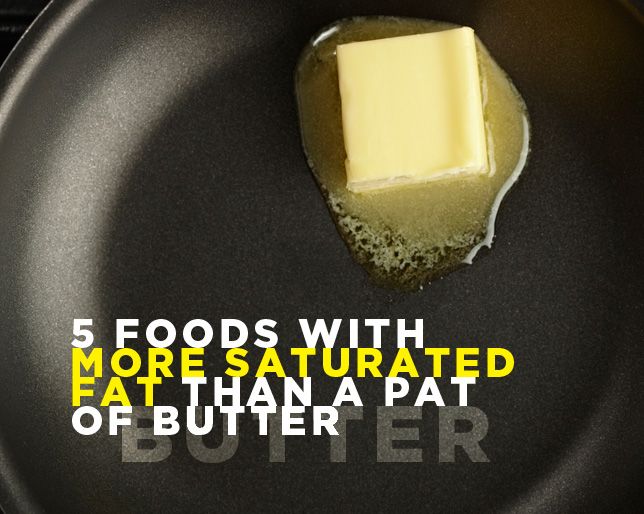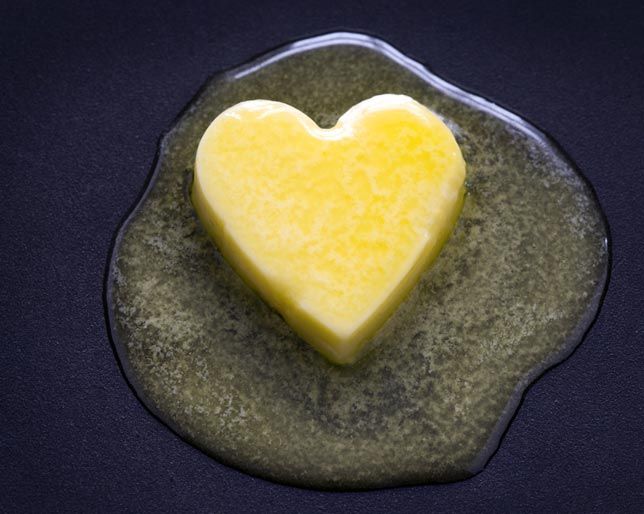Home » Diet & Food »
Putting Ghee In Your Coffee Isn’t The Best Idea If You Want To Lose Weight
Boy, have things changed since Regina George asked if butter is a carb. (Answer: No.)
Seriously, in the years since Mean Girls and margarine (cringe…), butter has practically become a health food.
In addition to cooking up veggies, meat, and eggs in butter again, people are even putting the stuff—specifically ghee—in their coffee. Buttery coffee has become such a “thing” that you can even order it at some coffee shops.
Curious (even if slightly disturbed)? Here’s what you need to know about fattening up your cup of Joe.
Back up. What is ghee, exactly?
Ghee, a.k.a. clarified butter, is made by simmering butter until the water and milk solids evaporate—and it has a different appearance, flavor, and nutrient profile than the stick of butter in your fridge.
“Butter contains milk solids and water, which give it a more opaque appearance and solid consistency,” explains says dietitian Cara Harbstreet, RD, of Street Smart Nutrition. “Since ghee is cooked over a long period of time, though, it contains only the butter’s fat.” Ghee typically has a more yellow or golden appearance, and is more translucent than butter when melted.
Here’s the nutrition info for a tablespoon of butter, according to the USDA:
- Calories: 100
- Fat: 11 g
- Saturated Fat: 7 g
- Unsaturated Fat: 4 g
- Carbohydrates: 0 g
- Sodium: 90 mg
- Sugar: 0 g
- Fiber: 0 g
- Protein: 0 g
- Cholesterol: 30 mg
And the nutrition info for a tablespoon of ghee, according to the USDA:
- Calories: 150
- Fat: 17 g
- Saturated Fat: 10 g
- Unsaturated Fat: 7 g
- Carbohydrates: 0 g
- Sodium: 90 mg
- Sugar: 0 g
- Fiber: 0 g
- Protein: 0 g
- Cholesterol: 25 mg
Essentially, turning butter into ghee concentrates its fats.
According to Harbstreet, ghee is generally 60 to 62 percent saturated fat, with most of the remaining fat content coming from monounsaturated fats.

Like butter and other animal products, “ghee also contains cholesterol, which the body uses to synthesize hormones,” she says.
While ghee has been a staple in Indian and Middle Eastern cooking forever, it’s become more popular in the United States only in recent years, thanks in large part to the rise of high-fat diet trends like keto and the Bulletproof Diet.
Ghee has also become a popular option among the dairy-intolerant, because it’s free of the milk solids and proteins in butter. Good news for Whole30 fans: Yep, ghee is also Whole30-compliant.
Cool. So can I put ghee in my coffee?
Fans of the ghee-coffee combo say that the fat-filled beverage helps them feel full and energized, so they can avoid sugar crashes and hunger pangs all morning long.
“Although ghee does contain more saturated fat than other foods, it can help you feel satiated and satisfied in the morning,” says Harbstreet. “Many breakfasts are high in carbohydrates, which are great for providing energy and fuel for your body, but may not have the staying power needed to get you through the morning.
Adding a source of fat to your morning meal, though, may help you avoid that dreaded mid-morning slump, she says.
Though some fatty coffee drinkers swear by skipping a solid morning meal, Harbstreet recommends pairing ghee coffee with a nutritious breakfast that also provides staying protein to keep energy high and hunger pangs at bay.
Compared to butter, ghee tends to have a nuttier, slightly sweeter flavor, which may make it a more desirable addition to your java. (Especially if you don’t love the bitterness of black coffee.)
Plus, if you’re following a low-carb or keto diet—or just trying to cut back on high-sugar creamers—ghee can make your morning caffeine fix more enjoyable without racking up the carbs.
It’ll also be easier on your gut if you’re sensitive to lactose, Harbstreet says.
Are there any downsides of putting ghee in my coffee, though?
Ultimately, “despite the many health claims being made about ghee online, the research behind most of these claims is limited,” says dietitian Summer Yule, RDN.
Plus, it’s important to keep in mind that ghee (like butter) is still high in calories and saturated fat. Though some experts now debate just how saturated fat affects health, the American Heart Association still recommends we limit it to 5 to 6 percent of our daily calories. For the average 2,000-calorie diet, that’s no more than 120 calories (roughly 13 grams) of saturated fat—the amount found in one tablespoon of ghee.

“If you have a weight-loss goal, it may be easier to meet your goal by getting your calories from satiating foods, rather than drinks such as ghee coffee,” says Yule.
Not to mention, if you regularly rely on ghee coffee alone for breakfast, you may miss out on important nutrients you’d get from a balanced meal.
That said, Harbstreet hesitates to recommend the ghee coffee trend for everyone. “There is no one-size-fits-all approach to improving nutrition, so take your taste preferences and current lifestyle into consideration,” she says. Don’t force any health or diet trend that doesn’t feel good for your body or schedule.
“If you’re curious, give it a try, but don’t think of it as a magic bullet for better health,” Harbstreet says.
Want to try Bulletproof coffee?
If you do want to try a fat-filled morning brew for yourself, go for it. This recipe from Bulletproof (basically the OG founder of the fatty coffee trend) will get you started.
https://www.instagram.com/p/By1c7CFB2Ea/
You’ll need:
- one cup of coffee (preferably brewed in a French Press)
- 1-2 tsp of ghee
- optional: 1-2 tsp of MCT oil
Combine your coffee and desired fats in the blender and blend for 20 to 30 seconds, until the ghee emulsifies and you have yourself a frothy latte-like drink.
Can I still do the ghee thing if I don’t like coffee?
If you don’t enjoy coffee or are sensitive to caffeine, don’t sweat; you can totally still get in on the ghee trend.
Just add ghee to your usual chai or matcha latte recipe, blend, and enjoy!
Source: Read Full Article

